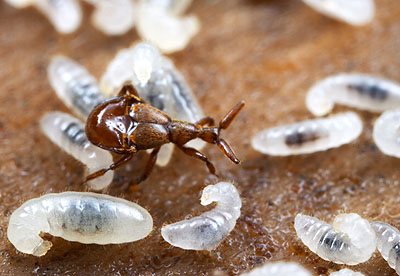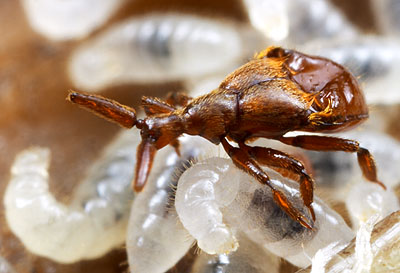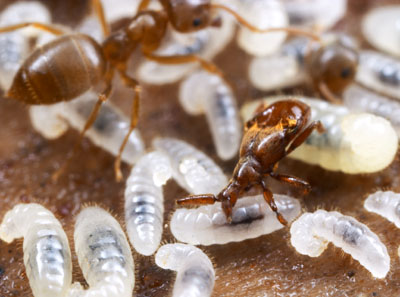

Adranes ant-nest beetle
California
The most exciting finds are often the least expected. I stumbled across this odd little beetle while collecting ants several years ago in northern California. It was tiny, only a few millimeters long, with a little blind nubbin for a head whose sole purpose seemed to be supporting antennae that looked like a pair of cricket bats. The Lasius ants whose nest played host to this strange creature did not appear to pay it any particular attention. Ants are normally rather vicious towards interlopers, so their nonchalance often reveals successful infiltration by a clever parasite.
From the perspective of a hungry arthropod, ant nests are oases in the desert. Ants concentrate impressive amounts of well-defended resources. Most would-be moochers are turned away with a little formic acid, but anyone able to crack the ants' defenses can help themselves to the riches. Getting around the guards requires a fair amount of specialization, and insects found in ants' nests usually show strange morphologies or enticing chemical mimicries. Although I didn't know the identity of this beetle, it clearly showed the telltale signs of a well-adapted parasite.
I vaguely recalled seeing a painting of an insect that looked like this in Hoelldobler and Wilson's now-classic "The Ants." When I revisted the illustration, it turned out to be a European species of rove beetle in the genus Claviger. It was similar to my mystery beetle but with several distinct antennal segments instead of the blunt club. With that lead in hand, a bit more looking about revealed my beetle to be in the closely-related American genus Adranes, also recorded to be an ant-nest inhabitant. As is true of most insect species, no-one knows much else about it. It likely mimics the odor of the ant larvae and tricks its hosts into feeding it.


Nice shots! How did you manage to get the shots of the ant nest with the ant larvae? Was the nest in the open or did you open up the nest somehow?
Thanks Calevphoto! The ant nest was in a rotting log on the ground, revealed by removing the bark. The beetle was just walking about in the ant brood.
The same ant species, Lasius pallitarsis, is common up your way. I'd not be surprised if you have Adranes too.
what a cute small creture... i like it!
I just collected a couple of these in the Sierra Ancha Mts., AZ, yesterday. Mother Nature was on acid the day she came up with that design. Your photography is absolutely breathtakingly good--like live Automontage! Keep up the good work!!!